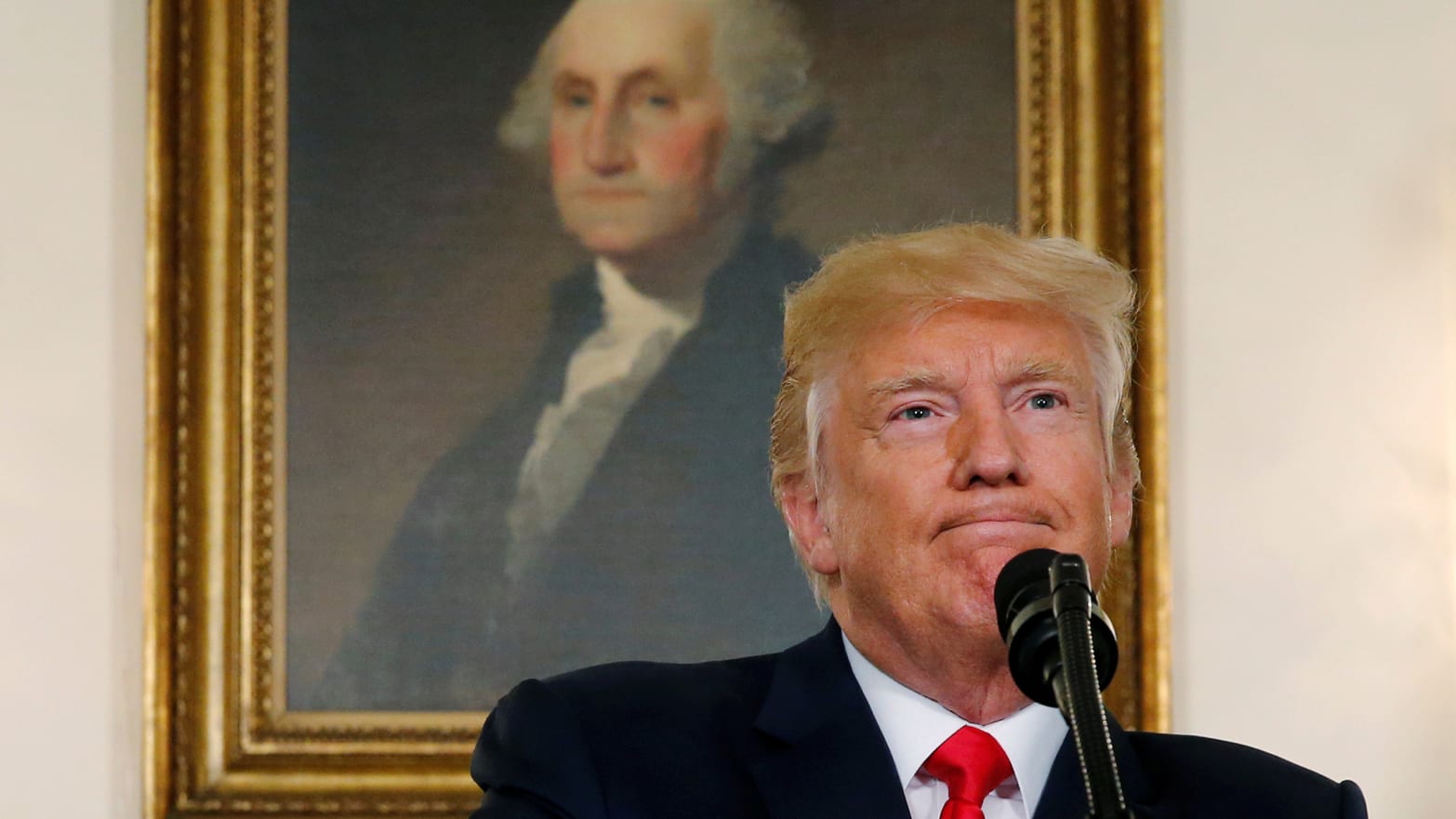President Trump can’t stop sticking his finger in self-inflicted wounds. But while his narcissism makes him numb to the pain he causes, the country suffers.
Today’s presidential Twitter tantrum praised the beauty of Confederate statues celebrating Robert E. Lee and Stonewall Jackson. “Who’s next, Washington, Jefferson?” the president tweeted. “So foolish.”
This is obviously a fight the president wants to have. Against a hailstorm of criticism from virtually everyone not named David Duke, Steve Bannon or Kayleigh McEnany, Trump is doubling down on comments at his moral abdication ceremony at the Trump Tower lobby on Tuesday, where the supposed leader of the Party of Lincoln provided cover for neo-Confederates and neo-Nazis, preached the gospel of moral relativism and still managed to sneak in a plug for his Virginia winery.
Praising the “very fine people” who were “there to protest the taking down, to them, of a very, very important statue, and the renaming of a park from Robert E. Lee to another name,” Trump decided to play civic historian. “So this week, it’s Robert E. Lee. I noticed that Stonewall Jackson is coming down. I wonder, is it George Washington next week, and is it Thomas Jefferson the week after. You really do have to ask yourself, where does it stop?”
It’s difficult for a president who admits that he’s never read a presidential biography to offer perspective on the sweep of American history. But if that’s what is needed to coax a bit of reflection from President Trump then we’ll indulge.
The difference between the Founding Fathers and Confederate generals is that one group created our nation and the other tore it apart, killing some 600,000 Americans in the process.
At the outset of the Obama presidency, paleo-conservative Pat Buchanan decried the rising diversity of our nation, writing in a syndicated column: “old heroes like Columbus, Robert E. Lee and Stonewall Jackson are replaced by Dr. King and Cesar Chavez.” It doesn’t take a mind-reader to see that Trump is playing the same tiny violin of resentment and resistance.
But Pat Buchanan is a pundit who lost his perch on MSNBC for appearing on hate radio. Donald Trump is president of the United States. Many of the marchers in Charlottesville were alt-right thugs, white supremacists and neo-Nazis giving stiff armed salutes. This ain’t subtle. Yet the president who doesn’t do nuance to suddenly wants to dive into the shades of grey when it comes to homemade hate groups.
Yes, as Trump pointed out, Washington and Jefferson owned slaves. It is cold comfort that Washington emancipated his slaves on his deathbed. But American history is complex and slavery was our nation’s original sin. We have to embrace the contradictions and transcend our tribalism to gain proper perspective rooted in our common humanity.
Context is key. That’s what New Orleans Mayor Mitch Landrieu pointed out in one of the best speeches of our young century, explaining why he was taking down the confederate memorials in his hometown. Most of the Confederate monuments were erected well after the Civil War to memorialize what he called “The Cult of the Lost Cause.”
“This ‘cult’ had one goal—through monuments and through other means—to rewrite history to hide the truth, which is that the Confederacy was on the wrong side of humanity…is self-evident that these men did not fight for the United States of America. They fought against it,” Landrieu said. “They may have been warriors, but in this cause they were not patriots. These statues are not just stone and metal. They are not just innocent remembrances of a benign history. These monuments purposefully celebrate a fictional, sanitized Confederacy; ignoring the death, ignoring the enslavement, and the terror that it actually stood for.”
So where does it stop? After all, the slippery slope argument seems irresistible to some conservatives. Today, it’s Confederate generals, tomorrow it’s motherhood and apple pie in the crosshairs. But the contextual standard offers a useful lens that can be applied.
Ken Burns, the pre-eminent documentarian and popular historian of our time, also weighed in on the subject during a discussion with The Daily Beast about his upcoming documentary on Vietnam.
“It’s a case by case basis,” he said. “If you’ve got a reactionary moment, or some moment in which you’re trying to intimidate, then you can take it down or put it in museums. But you’ve got to not bury the history, you’ve actually got to tell it.
“I was speaking a few years ago at the University of Mississippi and the day I had arrived they’d just pulled the state flag, because it contains the Dixie Flag, from the college campus. But here are all these lovely stained-glass windows about the university greys that went off from Ole Miss to fight. Don’t throw that away, but let’s contextualize it. You’ve also got Medgar Evers, James Meredith. You want to contextualize.
“One of the arguments the neo-Nazis and the neo-Confederates and the white supremacists make is that ‘You’re taking away our history.’ No one’s taking away your history. We’ve actually pulled back to say ‘can we talk about the old South?’ There were 9 million human beings in the South at the time of the war. Four million of them, 45 percent, were African Americans. Why can you talk about the white South? You talk about the South, why can’t we include that story, or haven’t you been excluding that story? When you learn the story of each of those monuments, you can determine whether it was an attempt to intimidate or an attempt to honor somebody there. And then you’ve got big, wonderful educational questions, and not necessarily the kind of warfare that we seem to have been encouraging.”
Let’s play it forward. Take President Woodrow Wilson, the subject of some left-wing protests a few years ago. Their argument was that his name should be removed from the Woodrow Wilson School of Public and International Affairs at Princeton University because of his shameful re-segregation of the federal government. But Woodrow Wilson was president of Princeton and governor of New Jersey. For all his faults, he was honored because of his long career in public service which culminated to two terms in the White House, not because he loved Birth of a Nation.
On the flip-side, look at Yale’s decision to rename Calhoun College for Admiral Grace Hopper. Its original namesake was remembered not just for being a Yale alumnus, secretary of state and vice president Andrew Jackson, but primarily for being the foremost advocate of allegedly constitutional theories of secession. The fact that the college was named in the 1930s is evidence of a “Lost Cause” agenda aimed at whitewashing his legacy. By that standard, Calhoun was a prime candidate to end up on the ash-heap of history, his legacy better suited to a museum than slapped on a dormitory full of diverse students.
But let’s get back to Washington and Lee and Trump. George Washington dedicated his life to securing our liberty and uniting our young nation. His core insight was that our independence as a nation was inexorably connected to our inter-dependence as a people. In his farewell address, Washington warned us about the dangers of demagogues exploiting partisan divisions to subvert our national unity under the banner of separatism paraded as pure Americanism. He called those men “pretended patriots” – and their modern inheritors seem to make up a significant portion of Donald Trump’s base.
Ever since Washington, presidents have recognized that they had a sacred obligation to try and unite the nation. It’s right there on national motto, e pluribus unum: out of many, one. But Trump does not seem concerned about uniting the nation. He seems unacquainted with the better angels of our nature. Trump is stoking the fires of fear and division for personal political gain. He is also torching the Party of Lincoln’s legacy by explicitly embracing neo-Confederates. And in the process, he degrades the office of president by robbing it of anything resembling moral authority.

